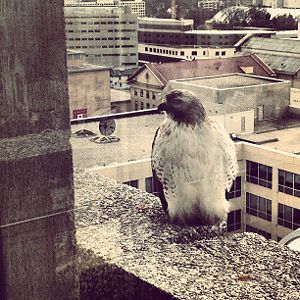Geometry and Topology Seminar 2019-2020
The Geometry and Topology seminar meets in room 901 of Van Vleck Hall on Fridays from 1:20pm - 2:10pm.
For more information, contact Richard Kent.
Fall 2014
| date | speaker | title | host(s) |
|---|---|---|---|
| August 29 | Yuanqi Wang | Liouville theorem for complex Monge-Ampere equations with conic singularities. | Wang |
| September 5 | |||
| September 12 | Chris Davis (UW-Eau Claire) | L2 signatures and an example of Cochran-Harvey-Leidy | Maxim |
| September 19 | Ben Knudsen (Northwestern) | Rational homology of configuration spaces via factorization homology | Ellenberg |
| September 26 | |||
| October 3 | Kevin Whyte (UIC) | Quasi-isometric embeddings of symmetric spaces | Dymarz |
| October 10 | Alden Walker (UChicago) | Roots, Schottky Semigroups, and a proof of Bandt's Conjecture | Dymarz |
| October 17 | |||
| October 24 | |||
| October 31 | Jing Tao (Oklahoma) | TBA | Kent |
| November 1 | Young Geometric Group Theory in the Midwest Workshop | ||
| November 7 | Thomas Barthelmé (Penn State) | TBA | Kent |
| November 14 | |||
| November 21 | Alexandra Kjuchukova (University of Pennsylvania) | TBA | Maxim |
| Thanksgiving Recess | |||
| December 5 | |||
| December 12 | Sean Li (UChicago) | TBA' | Dymarz |
Fall Abstracts
Yuanqi Wang
Liouville theorem for complex Monge-Ampere equations with conic singularities.
Following Calabi, Pogorelov, Evans-Krylov-Safanov, and Trudinger's pioneer work on interior regularities and liouville theorems for Monge-Ampere equations, we prove the Liouville theorem for conic Kähler-Ricci flat metrics. We also discuss various applications of this Liouville theorem to conic Kähler geometry.
Chris Davis (UW-Eau Claire)
L2 signatures and an example of Cochran-Harvey-Leidy
Ben Knudsen (Northwestern)
Rational homology of configuration spaces via factorization homology
The study of configuration spaces is particularly tractable over a field of characteristic zero, and much effort has gone into producing chain complexes simple enough for explicit computations, formulas for Betti numbers, and homological stability results. I will discuss recent work identifying the homology of the configuration spaces of an arbitrary manifold M with the homology of a certain Lie algebra constructed from the compactly supported cohomology of M. The aforementioned results follow immediately from this identification, albeit with hypotheses removed; in particular, one obtains a new, elementary proof of homological stability for configuration spaces.
Kevin Whyte (UIC)
The rigidity theorems of Mostow and Margulis for lattices in semi simple Lie groups are some of the most celebrated in their field, and are motivation for much of geometric group theory. Mostow's result, which states that every isomorphism between lattices extends to an equivariant isometry between symmetric spaces, has been generalized by Kleiner and Leeb to say that any map between higher rank symmetric spaces which is quasi-isometric (a large scale version of bilipschitz) is actually a perturbation of an isometry. Margulis' superrigidity theorem, which says every homomorphism between lattices which has infinite image extends to an equivariant isometric embedding of symmetric spaces, has resisted a generalization of this sort. We will discuss one such result, which considers when quasi-isometric embeddings of symmetric spaces are near isometric embeddings. Our results show that the situation is complicated - in some cases one does have rigidity while in others there are exotic quasi-isometric embeddings. What geometric properties distinguish the two cases is only starting to be understood. This is joint work with David Fisher (Indiana).
Alden Walker (UChicago)
In 1985, Barnsley and Harrington defined a "Mandlebrot set" M for pairs of complex dilations. This is the set of complex numbers c such that the limit set generated by the pair of dilations x-> cx+1 and x-> cx-1 is connected. The set M is also the closure of the set of roots of polynomials with coefficients in {-1,0,1}. As with the usual Mandlebrot set, M has strong connections to dynamics and algebra, and it has been studied by Bousch, Bandt, Solomyak, Xu, Thurston, and Tiozzo. For a geometric group theorist, the study of M is qualitatively similar to the study of Kleinian groups acting on their limit sets or on universal circles.
Barnsley and Harrington noted the (numerically apparent) existence of infinitely many "holes" in M, which correspond to exotic components of the space of Schottky semigroups. Bandt rigorously confirmed a single hole in 2002 and conjectured that the interior of M is dense in M away from the real axis. We give the new technique of "traps" to certify an interior point of M, and we use these traps to prove Bandt's conjecture and certify the existence of infinitely many holes in M.
The only prerequisite for this talk is point-set topology. Fun pictures will be provided. This is joint work with Danny Calegari and Sarah Koch.
Jing Tao (Oklahoma)
TBA
Thomas Barthelmé (Penn State)
TBA
Spring 2015
| date | speaker | title | host(s) |
|---|---|---|---|
| January 23 | |||
| January 30 | |||
| February 6 | |||
| February 13 | |||
| February 20 | |||
| February 27 | |||
| March 6 | |||
| March 13 | |||
| March 20 | |||
| March 27 | |||
| Spring Break | |||
| April 10 | |||
| April 17 | |||
| April 24 | |||
| May 1 | |||
| May 8 |
Spring Abstracts
Archive of past Geometry seminars
2013-2014: Geometry_and_Topology_Seminar_2013-2014
2012-2013: Geometry_and_Topology_Seminar_2012-2013
2011-2012: Geometry_and_Topology_Seminar_2011-2012
2010: Fall-2010-Geometry-Topology
